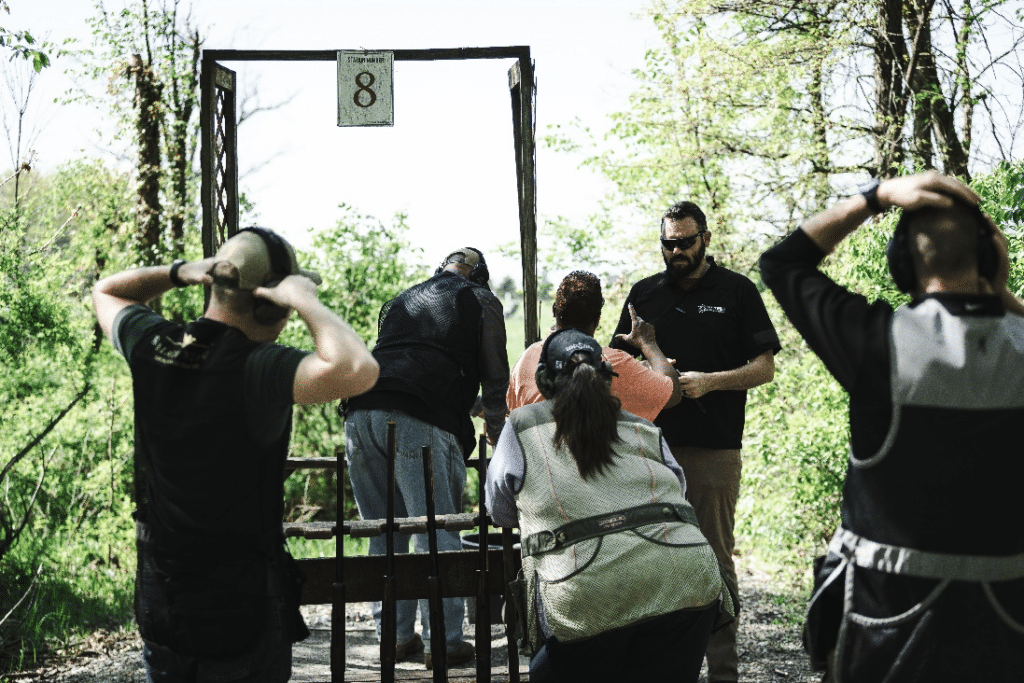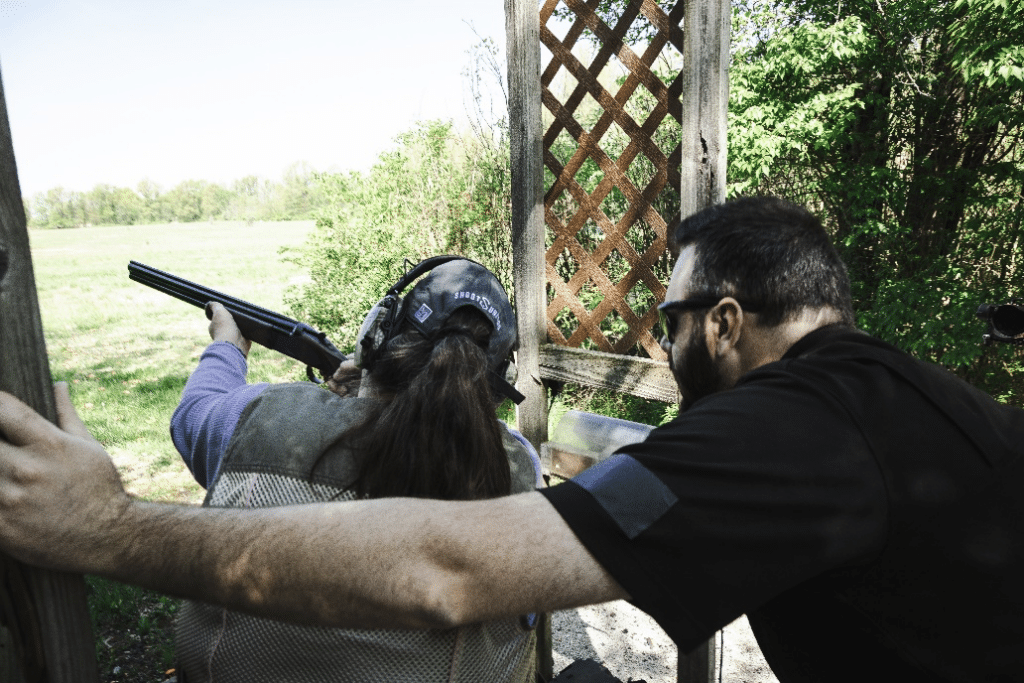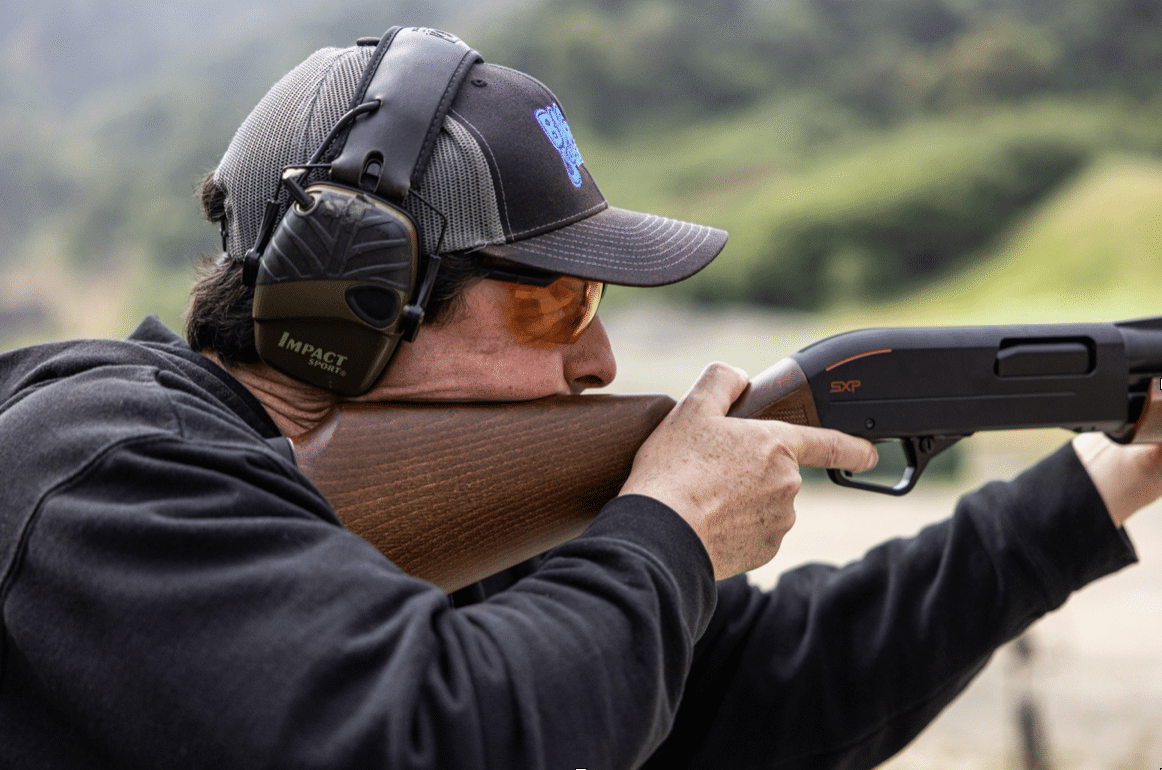Golf … with a shotgun. Yes, the best way to describe sporting clays is that it’s like golf with a shotgun. You aren’t shooting golf balls nor are you swinging a shotgun like a golf club (don’t ever do that). The similarities are that sporting clays courses have different stations, just like golf courses have different holes and each station presents a different challenge. No two sporting clays courses are alike. Terrain, background, and the way targets are presented all differ from course to course. Many sporting clays shooters travel the country to visit as many different courses similar to how avid golfers travel the country in search of pristine greens and fairways.

Station 8 at Black Wing Shooting Center’s sporting clays course in Delaware, Ohio
History of Sporting Clays
Sporting Clays began as a British game and dates back to the early 1900s. It wasn’t until 1980 that the game came to the United States. Before this, the only shotgun sports in America were Trap, established in the 1800’s, and Skeet, established in the early 1900’s. The support of Winchester, Remington, and other big names such as du Pont cemented sporting clays as a shotgun sport that would stick around. Since coming to the United States, it has exploded in popularity, to the point of being one of the most popular recreational shooting sports activities in the country.
What do you need to play?
The equipment list for sporting clays is minimal. At a bare minimum, you’ll need eye and ear protection, a shotgun and ammunition. Targets are generally supplied by the gun club you are visiting. The graphic below contains all the common equipment for sporting clays. information on your new box of handgun ammunition means. We’ll break down the most important terms throughout the rest of the article.

What kind of ammunition do you need?
For sporting clays, you’ll need to use target shotshell ammunition. Not all shotshell ammunition is the same. There are different gauges, shot sizes, and shot weights to consider.
- Gauges – You can use a 12 gauge, 20 gauge, 28 gauge, or a .410 to shoot sporting clays. 12 and 20 gauge are the most common for sporting clays. 28 gauge is quickly rising in popularity as well.
- Shot sizes – Sporting clays shot sizes range from 7 1/2 shot to 9 shot. The higher the number the smaller the shot size. For more information on shot sizes, visit our Shotshell Ammo 101 graphic.
- Shot weight – Weights for sporting clays loads range from 1/2 oz in .410 loads to 1 1/8 oz in 12 gauge loads. 1 oz is generally the most common shot weight for sporting clays loads. For more information on shot weights, visit our Shotshell Ammunition blog

Winchester AA ammunition is arguably the best target shotshell load for sporting clays, trap, and skeet.
What about chokes?
Shotgun chokes are an entirely different subject to discuss. For more information on what shotgun chokes are, and how they work, refer to our blog, “What is Choke in a Shotgun”.
There isn’t one best choke for sporting clays. Part of the challenge with sporting clays is that targets are presented at different speeds, angles and distances. Some will be close, some will be far, and some will be in between. The best strategy is to have at least 3 different chokes with you that cover close, mid, and long-range targets.
Recommended chokes for sporting clays based on distance:
Long-Range: Improved Modified, Full, or Extra Full
Close-range: Cylinder, Skeet, or Improved Cylinder chokes
Mid-Range: Light Modified or Modified chokes

Your shotgun usually comes with a set of chokes, but there are plenty of after-market choke options to explore.
How to play
A typical round of sporting clays will consist of 50 to 100 targets shot in total across different stations of a sporting clays course. Shooters are organized by squads, and a squad can contain two to five participants. The squad will begin at the first station and shoot each following station in order. At larger sporting clays competitions, squads may be assigned to start at different stations to keep everyone moving and prevent back-up on the course.
Once at the station, the scorer for that station will show your squad what the targets thrown at that station look like. This example allows participants to understand where the targets are coming from and strategize how to hit them.

Shooters visualize breaking clay targets when shown the targets at a sporting clays station
The first shooter in the squad will step up to the station, point their firearm towards the direction of the targets, load two shotshells, and when ready, call “pull.” The targets will then be thrown.

A shooter takes aim at a target thrown.
Each shooter in the squad will be presented with two targets at each station. These targets can come in the form of singles, following pairs, report pairs, or true pair.
- Singles – One clay target is thrown when the participant calls for the target to be thrown.
- Following pairs – The shooter calls for the first target to be thrown. The second target is launched at the scorer’s discretion after throwing the first target.
- Report pairs – Similar to following pairs, but instead of waiting a few seconds, the scorer throws the second target as soon as the participant fires at the first target.
- True pair – Two clay targets are thrown at the same time.
After firing at both targets, and absolutely crushing them (obviously), the shooter will open the breech of their shotgun, remove the empty hulls, and place the unloaded firearm back on the firearms rack at the station, or, with the breech still open, progress to the next station.

Shooters move to the next station safely with the breeches of their shotguns open.
What do the targets look like?
We’ve talked about the different ways that targets can be presented at stations but unlike trap and skeet, sporting clays incorporate different-sized clay targets to add to the challenge. The graphic below shows the different targets, their size, and purpose. You’re not guaranteed to find each target used on a course. Some courses may use different combinations than others.


